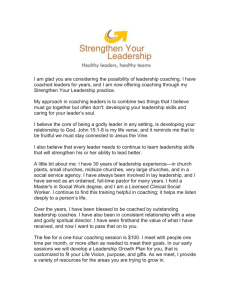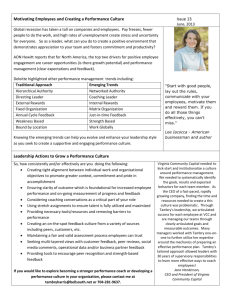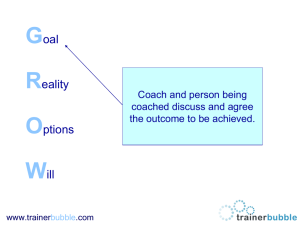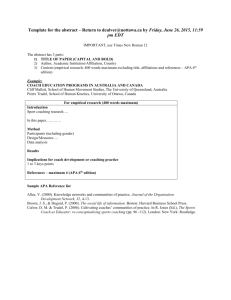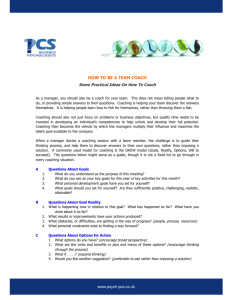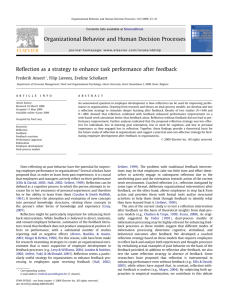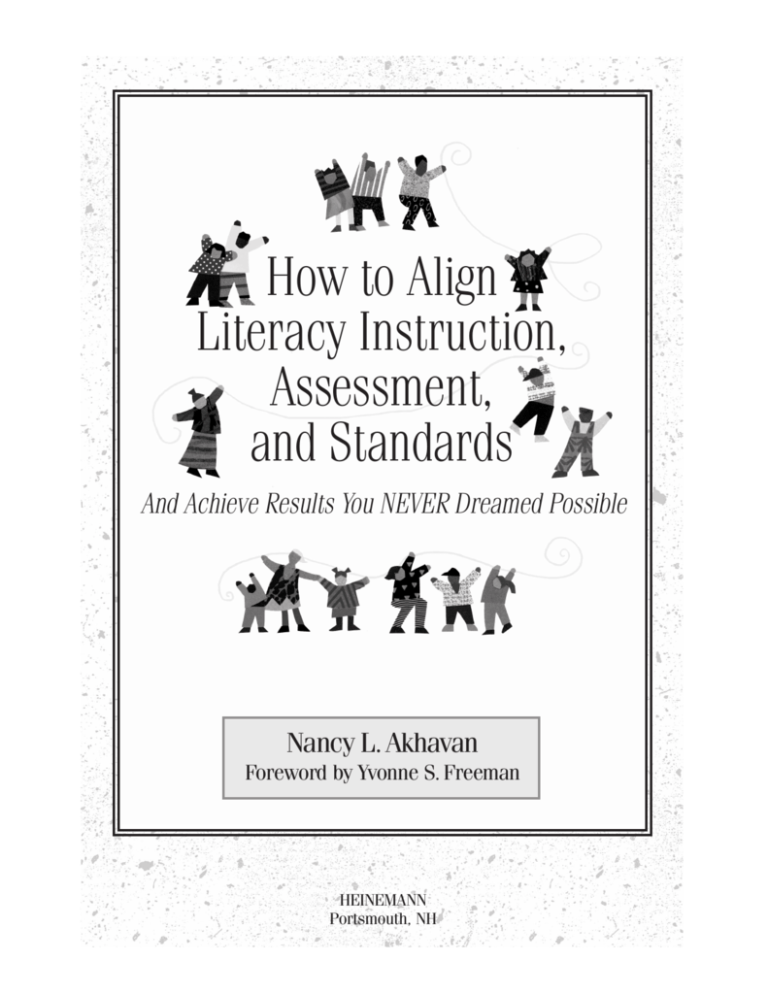
How to Align
Literacy Instruction,
Assessment,
and Standards
And Achieve Results You NEVER Dreamed Possible
Nancy L. Akhavan
Foreword by Yvonne S. Freeman
HEINEMANN
Portsmouth, NH
Heinemann
A division of Reed Elsevier Inc.
361 Hanover Street
Portsmouth, NH 03801–3912
www.heinemann.com
Offices and agents throughout the world
© 2004 by Nancy L. Akhavan
All rights reserved. No part of this book may be reproduced in any form or
by any electronic or mechanical means, including information storage and
retrieval systems, without permission in writing from the publisher, except
by a reviewer, who may quote brief passages in a review.
Library of Congress Cataloging-in-Publication Data
Akhavan, Nancy L.
How to align literacy instruction, assessment, and standards : and
achieve results you never dreamed possible / Nancy L. Akhavan.
p. cm.
Includes bibliographical references and index.
ISBN 0-325-00662-8 (alk. paper)
1. School improvement programs—California—Hanford—Case studies.
2. Educational accountability—California—Hanford—Case studies.
3. Effective teaching—California—Hanford—Case studies. 4. Teachers—
In-service training—California—Hanford—Case studies. 5. Lee Richmond
School (Hanford, Calif.)—Administration—Case studies. I. Title: How to
align literacy instruction, assessment, and standards and achieve results
you never dreamed possible. II. Title.
LB2822.83.C2A54
371.2′03—dc22
2004
Editor: Lois Bridges
Production: Lynne Reed
Cover design: Jenny Jensen Greenleaf
Cover illustration: Laura DeSantis/Getty Images
Typesetter: Technologies ’N Typography
Manufacturing: Steve Bernier
Printed in the United States of America on acid-free paper
08 07 06 05 04 VP 1 2 3 4 5
2003028094
Take My Hand
Coaching for Experience
Looking Closely at Coaching
■
■
■
■
Consider how you learn. Have you ever worked with a coach to change
your instruction?
Consider meeting with a colleague and coaching one another.
Consider the types of conversations you usually have with colleagues.
Are the conversations powerful?
Consider reflecting on your practice. What student work have you kept
from the past? How does the work inform you of your growth as a
teacher?
I know what an orange grove looks like from above, where the leaves touch
the sky. The view is very different from when you are standing on the
ground. When the oranges are in bloom, their heavy fragrance surrounding
you like a blanket, your senses drown. I know exactly how breathtaking the
view is, because I saw it from the rooftop of friend’s shed when I was ten.
After sitting on the roof, feeling the breeze and the warm scent of orange blossoms wrap around me, I learned something else, a feeling less
pleasant. I learned how it feels to be frozen with fear. I panicked; I was not
able to get off the roof. My friend scurried down, jumping the small gap
between the roof and the ladder without a problem, but when I neared the
edge of that roof, fear clung to my hands. I was not able to swing my feet
down onto the rungs. I could not move close to the edge. The feeling of
helplessness spread through me, beginning in my stomach and radiating
up my chest until I couldn’t see straight. My friend tried hard to coax me
down. She stood on the ground and called up. She told me I could do it, I
could slide onto the ladder, but I didn’t believe her. Then her mother
climbed up and said, “Take me by the hand.”
1
Coach and Be Coached
The best ways to improve your practice are to plan, set goals, and reflect
with a coach. A coach is someone who is willing to lend you a hand and
tell you the truth. That may not always be what you want to hear, but what
you need to hear. A coach is open, honest, upfront, and pushes you to excel.
It is not a good idea to choose your best friend as a coach; sometimes the
friendship stifles the needed open, honest communication. I encourage you
to choose someone at your school site you can work with—someone you
trust enough to share your teaching and the results of your instruction.
At Lee Richmond School (LRS) we have a community of coaching. The
literacy coach and learning director spend their whole day in the classrooms modeling, watching, listening, observing, and reflecting. Many of
the teachers at LRS also coach one another. Sometimes they do this through
formal meetings and observations that they have set up in advance. One
teacher might ask to be released to visit another classroom to watch a colleague teach something in her field of expertise. Later the teachers might
meet and discuss what happened in the lesson. Teachers also visit classrooms of other teachers in the district.
I visited the classroom of a teacher in another school in my district.
Patty is a third-grade teacher, and she runs an outstanding writing workshop. I visited the room with my colleague and coach, Jan, who is Patty’s
learning director. I wanted to learn how Patty confers with her students to
help them become better writers. Patty’s students use details in extremely
effective ways in their writing. I loved my visit to Patty’s class. I learned
from watching her. I watched carefully how she approaches a child, what
she says to them, and how her walls reflect their learning. The interesting
part of watching someone else teach is that you learn, and you learn even
more when you know what to look for. I was looking for the essence of
what she did when conferring with students so that I could take it with me
to improve my own conferring skills. I learned by watching how a teacher
in a school different from mine conferred with her students. I listened to
what she said, and I read her student’s writing. I noticed how the children
decided to put details in their stories, and why they made their choices.
What is important about this is that while I was learning by watching Patty,
my coach, Jan, was also prodding my learning. She sat down beside me
and asked, “So what do you notice?”
“Patty is really specific about beautiful language. She uses a lot of mentor text, pulling out words, phrases, and ideas of how authors say things in
interesting ways. I also notice that she uses the students’ writing as mentor
text also,” I replied.
“So,” Jan questioned, “How do you think it is different from what
you’ve done in your work at LRS?”
“Well,” I thought for a moment, hesitating because it was a hard question. “I think I haven’t shown how to use mentor text effectively. This work
2
Take My Hand
reminds me of Katie Wood Ray’s book, Wondrous Words: Writers and Writing
in the Elementary Classroom [1999]. I think Katie talked about how to create
lessons for students to notice words and add specific words to their writing. I think I need to read her book again and try this line of mentoring in
my conferring.”
Jan didn’t let me off the hook. She followed up with me a few weeks
later to see if I indeed had tried to use mentor text more effectively. I had,
and I also had experimented with using mentor text to teach effective dialogue use. I was pleased with my results. I felt more in control of my teaching because I had something to reflect upon, an ideal, an image, and a way
of knowing.
Coaching Every Day
Day in and day out I do a lot of coaching. I believe that coaching falls in
different areas: demonstration, inquiry, and instruction.
Demonstration and Reflection
Jan and I had a conversation one day about some student writing from
Patty’s classroom that Jan showed me. I noticed that Patty’s students consistently used beautiful descriptive language in their writing. I asked Jan to
help me improve my teaching so that I could improve my instruction and
share my insights with my teachers. Jan suggested that I visit Patty’s room
so that Patty could demonstrate. While I was in Patty’s room and when we
debriefed, Jan asked me questions that made me think. She forced me to reflect on what I saw and what it meant to me in relation to my own work in
writing workshop.
I too have demonstrated lessons for teachers who request to see something specific. Christy was unsure of how to begin nonfiction with students
who were reading at about the early fluency level. She wanted the children
to feel as confident in reading nonfiction as they did with easier fiction
books. During our conversation, Christy indicated that she wanted to see
me teach a guided reading lesson using a nonfiction book. We arranged a
day, and I taught her group. Since I was Christy’s coach, while providing
the demonstration lesson I stopped instruction from time to time to talk
with Christy about what I was doing in the lesson, and what she noticed or
thought. When I was done with the lesson, I sent the children to read in
pairs, and Christy and I met immediately to reflect on how well the lesson
went and what she felt was new knowledge for her about her reading instruction.
Inquiry and Reflection
Inquiry is another way of coaching. Inquiry usually begins when one of my
teachers drops by my office or catches me in the hall and says, “I’ve been
thinking about trying something new, and I need you to tell me what you
Take My Hand
3
think about my structure [or lesson]. I am not thrilled with how things are
going.” A coaching session focused on inquiry opens when the teacher
poses questions about her lessons. Andrea is a fourth-grade teacher at LRS,
and one day she and I were looking at her student work from a book inquiry. On this day, she brought her reading response journals to my office
and we spread them out.
“I see that your kids are kind of all over the board with their thoughts
on this book,” I said.
“Yeah, I am frustrated because I feel like I am being specific in the
minilesson about what they should do, but look . . . the entries don’t look
any different than they did two months ago when I was reading a very different type of book.” Andrea pointed to a few student entries.
“What was the other book?”
“Island of the Blue Dolphins [O’Dell, 1960].”
“I think there are a lot of similarities in the theme of the book Riding
Freedom [Ryan, 1998]. I really think there are similarities in the character
traits between Karana in Island of the Blue Dolphins and Charlotte in Riding
Freedom.”
“Well,” Andrea hesitates, “That is true, but I have focused differently.
During Island of the Blue Dolphins, they had to respond in groups first and
write their response together on a chart; now I have them working independently in the response journal. I thought they could get it, because with
Island of the Blue Dolphins, I guided the thinking and structure for them to
practice and get the hang of analyzing the author’s intent and how that relates to the characters’ actions.”
“If you feel strongly that you modeled that enough with the Island of
the Blue Dolphins read-aloud, then that is probably not the problem.” I
pause to scan the student reading response journals. “What else do you notice about your kids while they are reflecting independently?”
“They can say what they know—they stop and share out loud. That
part is great; they never used to be able to do that. But when they write,
their ideas are cut off, there is so much less writing than what is in their
discussion.” Andrea pointed to one student’s writing to show how shallow
the response was.
“I see what you mean. Let’s pinpoint that; maybe you need to show
them how to do more extensive jotting in a few minilessons?” I asked.
“Yeah, maybe they just need to see it more, discuss how to do the writing, not what the book is about at this point. It is more of a structural problem. They just don’t know how to write about their thinking,” Andrea said.
“I think you are onto something.”
Andrea was onto something, and she solved her own problem just by
looking at student work and talking through the lesson—what she remembered her students doing, saying, thinking, and writing during the lesson.
We delved into her students’ actions, compared her ideas with their writing, and she developed a plan to move ahead.
4
Take My Hand
Instruction and Reflection
Often as a coach I am instructing. The focus of my instruction is not the
children, but the adults. I am learning, and the teacher is learning. Together
we discover ways to best handle problems areas with instruction. We also
learn together how to change our ways. When I coach through instruction,
I also plan professional development, schedule a book talk on a professional text I have read recently, or perhaps film myself and others teaching.
Overall, I share my knowledge, and I expect others to do the same. We
need to be involved in teaching one another. We need to focus on changing
our instructional practices by incorporating best practices and letting go of
instruction that doesn’t teach the whole child.
One thing that’s hard to admit as adults is that we like to do things the
way we’ve always done them. Old ways are comforting. New ideas, new
methods of teaching can be threatening, mostly because we may not feel
we have the expertise to pull off the lesson well. That is one reason teaching from worksheets and following directions in a basal is more comforting
initially. We don’t have to think. But in the long run, children don’t learn
critical divergent thinking skills from filling in blanks; they also don’t all
learn to read that way. This is critical for those of us in California to realize.
Currently, the state has adopted only two reading programs for use in K–6
schools, and both of those programs use large numbers of worksheets and
convergent thinking activities to teach literacy. But this approach doesn’t
help our children grow into literate adults who think critically.
Reflect on Real Events to Improve Instruction
During a recent construction period at the school, I felt like I was caught in
a really bad episode of Trading Spaces (a home-improvement show on cable). The school administration building had been built in 1953. Our school
had grown to the point that the tiny administration building, staff lounge,
and workroom no longer served our purpose. That fall we were to have a
gorgeous new building housing our library, offices, workroom, and staff
lounge. The problem was that school was opening in two weeks and the
work wasn’t even close to being completed!
While stepping around the construction site one day, I wandered over
to check out the commotion in the middle of the sidewalk near the new
building. For three days the staff had been working without any water, and
we were promised water soon. However, I discovered that the water
wouldn’t be coming back on as quickly as we had hoped. The water main,
which was in the “off” position, had been cemented over. It was smack dab
in the middle of our brand-new eight-foot-wide sidewalk.
This situation felt so awful, it was funny. The next morning I saw
the foreman for the project. He began to tell me that the water had been
turned back on the night before. I pointed to the very large chunk of
concrete missing in our new sidewalk and said, “This is why we don’t
teach by using worksheets at this school.” (I am not sure that he was
Take My Hand
5
interested in our curriculum; however, to me, the analogy made perfect
sense.)
“What?” he queried.
“Worksheets—I bet that whoever made that particular mistake grew up
with worksheets. He was just checking off a box on his list; he never
thought, there is a valve there, is that a problem? He just kept going, not
thinking or questioning what would make sense!” I exclaimed.
The foreman nodded and laughed, “Oh, you bet! Did you see the lack
of thinking on the new air-conditioner unit for your older building?”
“No . . . should I have noticed?”
“Didn’t you see the rigged-up copper tubing coming down, right
where your kids line up after recess?”
“Yes, but I thought it was temporary.”
“No, that was put in by another person just checking off the box. His
directions said to put the condensation tube down the building, but they
didn’t say where. He made the worst possible choice he could have. Maybe
he had worksheets in school too!”
Standing in the middle of a construction site, two weeks before school
started, I received my inspiration for purpose. Everyone needs renewed
purpose from time to time, especially when others around you do the same
old thing, in the same old ways. This foreman said to me, “I need more critical thinkers.” Well, I walked back into my makeshift office and began
planning the professional development to support our new learning during
the new school year. At the top I wrote Critical thinkers. Then I wrote, We
have to begin with ourselves. I began my focus for the instruction of the adults
in our learning community.
Reflect on Your Practice
How to Align Literacy Instruction, Assessment, and Standards and Achieve Results You Never Dreamed Possible is designed so that I can coach you from
the sidelines. Hopefully, reading each chapter will be a critical thinking activity. I encourage you to
■
■
■
■
think
discuss
ponder
question
the ideas you will find throughout the book. The remainder of this chapter
will help you gather evidence of your successes and think about setting
goals that the book can help you plan.
But just as I learn from coaching and being coached, you need do this
thinking, discussing, pondering, and questioning in collaborative relationships. You will grow professionally, and you may even find that with the
support of a colleague, you are able to change your instructional practices.
6
Take My Hand
These relationships begin with conversations that focus on your own critical thinking as well as on how to develop literacy and critical thinking in
all children.
Conversations
During any of the coaching models I have described, it is important that we
focus on having a dialogue. Dialogue is different from talking. Dialogue is
listening and reflection. Coaching conversations should be more listening
than speaking. What are you telling me about your students and your instruction? It takes courage to have real conversations with one another—
we have to be willing to let down our defenses, share our instruction with
one another, and share our ideas about how to improve. These are not always comfortable subjects to talk about. It takes courage to say things as a
coach that we don’t normally say to one another. As teachers, we get so
used to giving each other positive, unspecific encouragement, or no encouragement at all, that we don’t know how to hold a dialogue with a colleague about our instruction.
Coaching and being coached can be an incredibly rewarding experience. When I am open to the ideas suggested to me by my coach, or when I
am able to understand what a teacher is telling me they need help with, I
gain more from the experience. Margaret Wheatley (2002) has written a
beautiful and sensitive book called Turning to One Another: Simple Conversations to Restore Hope to the Future. When I open this book I feel calm, and I
find nuggets of wisdom to increase the effectiveness of my coaching experiences. In this book she writes about courage. She believes that if we return
to dialogue, to listening, we can solve many problems we face in isolation.
Some of the points that she makes in her book I type and place in my
school planner. I remind myself of these ideals over and over when I am
entering into coaching conversations with a colleague:
■
■
■
■
■
Ask what’s possible, not what’s wrong. Keep asking.
Be intrigued by the differences you hear.
Trust that meaningful conversations can change your world.
Expect the conversations to be messy at times.
Don’t be afraid to be open.
When we coach we need to think for ourselves. Coaching doesn’t mean
running your ideas over a colleague. Coaching means pushing, prodding,
and relentlessly making your colleague reflect on his teaching practice.
Then, once your colleague comes to an understanding of need, it means
dropping a few ideas for improvement. This is intimidating for all involved. The person being coached has to remain open to hear what the person coaching is saying, and the coach has to remain open to hear what the
individual needs, thinks, fears, and loves. This also means being there for
the person you are coaching. Standing at the bottom of the ladder and yelling encouraging words is one way of being involved, but stepping up the
Take My Hand
7
ladder and saying “Take me by the hand” is a thousand times more productive for both people. The times that I have been coached hard are the
experiences from which I have learned the most.
Develop a Personal Portfolio
We all need reassurance. Mine is in a large brown cardboard box. Inside the
box are my treasures. These items from school tell me about the power of
learning at LRS. The pieces in my box are reminders of where I have been
professionally and where I want to go. The box is really full, and the items
inside range from pictures, letters, and test scores to students’ writing
pieces, running records, lesson plans, and teacher planning notes to favorite articles and excerpts from books that help me teach. The pieces are in
the box because they remind me of the palette of learning at Lee Richmond.
This collection reflects my abilities as a principal and a teacher.
It is important to have a collection of items that reflect the abilities of
your students and of yourself as a teacher. Many items I keep as part of my
school portfolio, and I use them to explain our successes to the superintendent, parents, public, and board members. I also have the items that direct
my thinking and show me where we are as a learning community. At a
conference, I can lay down pictures of classrooms, student writing, and
reading scores to show visitors and evaluators how well our children are
learning.
My Reassurance Box
Let me show you inside my reassurance box.
I have three pieces of first-grade writing from the 2002–2003 school
year. These pieces are important to me because they are from a group of
students that left kindergarten writing, and writing well, for the first time.
This is significant because our instruction in kindergarten changed; we
stopped teaching with worksheets and writing forms and began with writing workshop. First, I have Leighton’s piece of writing (see Figures 1 and
2). I purchased this book from Leighton, a first-grade student in Shana’s
room, with a gift certificate from Barnes and Noble. She was very excited to
make her first “sale” as a published author. I treasure this work from
Leighton because she worked hard to be able to control beginning, middle,
and end effectively in her writing. She especially worked to learn how to
use reflection in her writing to end her narrative. She submitted this story
to the Lee Richmond School Author’s Faire, and at the event participants
and visitors were invited to write comments on the inside front covers of
the books. Leighton wrote, “I have a gret story.” I thought she had written
a great story too. It is in my reassurance box because it reminds me that
when Shana, Leighton’s teacher, provided precise instruction and created a
beautiful, nurturing, literate classroom to support writing, Leighton
learned. I am also reminded of the coaching relationships at the school.
8
Take My Hand
FIGURE 1
Page One from Leighton’s Book
Kristina, the literacy coach, coached Shana. Originally written with invented spelling, this sample is translated.
When We First Went to The Lake
Leighton Napier
Once I went to the lake. And I remembered that there was no gas in the jeep.
So I told my mom, “Get gas first.” But my mom and dad said, “Oh it’s going
to be all right.” But a couple of days later my jeep broke down. And we just
had to sleep in the cold. Well, I growed and growed. A couple of days later a
policeman came and checked on people. All of a sudden the police man saw
us and said, “What are you doing out here all by yourselves?” “We broke
down,” said my dad. “I can help you get home.” We said, “All right.” We
went home and drawed pictures of how beautiful it was. I will always remember that day.
Another example of first-grade writing is Marc’s piece (Figure 3). Marc
wrote a narrative about an experience his mother had. He also learned to
Take My Hand
9
FIGURE 2
Page Three from Leighton’s Book
control beginning, middle, and end effectively. Notice how he uses dialogue, like Leighton, to add specificity to the story. Marc also uses literary
language. He begins with a long, long time ago, when . . . and sound words
like crackle, creak, crackle.
3-31-2003 Marc Aguirre
A long long time ago when my mom worked at R-N and one spooky dark
night when my mom, Grace, went to bed, she had a bad dream. [Shana had
shown the children how authors use the strategy of leisurely beginnings. This
looks like Marc’s attempt at a leisurely beginning.] She dreamed that when
she was working at R-N a robber went up to her register and told her to put
the money in the bag and Grace said, “Are you serious?” then he held up the
gun and said, “Does it look serious?”
Then she put the money in the bag. And the next morning when she wok
up, she drove herself to work. And then . . .
10
Take My Hand
FIGURE 3
Marc’s Piece as He Wrote It
BUST the door broke open and a robber went up and said, “Put the money
in the bag.” And he held the gun to my mom Grace. If he shoots it will go,
bang, bang. Then she said, “Ok, Ok.” And after he left she thought why is it
just like my dream? She wondered. And when she told me that story, I told
her, “Why didn’t you call the cops?” And she said that she was shaking with
fear. When she was biting her nails with fearness [Marc told Shana that
fearness is being really, really frightened], They went creak, crackle, creak,
crackle. Then she told me that she wanted to forget that scary, scary day but
she just couldn’t. and she said to herself repeating, “I will never forget that
day, I will never forget that day.” I’ll never know if . . . she really did. The
end.
Take My Hand
11
FIGURE 3
12
(continued)
Take My Hand
FIGURE 3
Take My Hand
(continued)
13
FIGURE 3
14
(continued)
Take My Hand
FIGURE 4
Kimbra’s Writing
The third example of first-grade writing is Kimbra Juarez’s piece about
butterflies (see Figure 4). Kimbra wrote this piece in November. Kim, the
learning director, coached her teacher, Sonia, on how to teach the children
to add specificity to their pieces. You can see the development of specificity
in this writing sample.
Take My Hand
15
FIGURE 4
16
(continued)
Take My Hand
FIGURE 4
Take My Hand
(continued)
17
FIGURE 5
Jacob’s Reflection Sheet
My portfolio (or reassurance box) also has breadth. I have reflection
sheets that two students wrote in 2002 about our Read On Richmond! campaign. During this campaign, the whole school focused on reading a lot
and reading often. Jacob wrote about how he feels about his writing. I have
Jacob’s reflection in my box because I hear my voice in his writing. Many
times at schoolwide assemblies, during recess, in the lunch line, and when I
am visiting classrooms I am telling the children why they should read. Figure 5 is Jacob’s reflection on why reading is important.
18
Take My Hand
FIGURE 6
Crystal’s Reflection Sheet
Translation
I like reading fiction things of sorts. I love Harry Potter the best. The best
techniques for reading is chunking and start at reading little books, then bigger and bigger books. Then before you know it you’ll be reading encyclopedias or possibly books that you didn’t know existed. I think you know what I
mean. I read this many pages by little books and then big books. SO READ.
I also have Crystal’s reflection sheet (Figure 6) in my remembrance box.
When I read her work, I think of Crystal snuggled up with her mom reading. Crystal’s mom works as a yard supervisor at our school. She nurtures
the children just the way she does Crystal’s reading abilities. I kept this
Take My Hand
19
FIGURE 7
Sienna Reading in Sonya Johnson’s Library
FIGURE 8
Sonya Johnson’s Library
20
Take My Hand
FIGURE 9
Passion Heart from Amanda’s Classroom
piece because when I read it I think of the wonderful literature experiences
we need to provide our children in our classrooms daily.
In my box I also have a picture album. While many of the pictures are
of proud children showing off their work, most are pictures of the walls in
LRS classrooms. I usually take pictures to remind us how important our environments are. Environments set the tone of learning, support the children’s understanding, and when designed well, bring us peace and
Take My Hand
21
FIGURE 10
Cherie and Anissa in a Classroom Library
FIGURE 11
Jayden Reading Her Piece at a Writer’s Celebration
22
Take My Hand
FIGURE 12
Alyson’s Piece
motivation. How we arrange our rooms, create spaces for children to read
and write, and display student work impacts the rigor and quality of learning.
For information on how to create passion hearts, see Awakening the
Heart by Georgia Heard (1999).
I have a piece of second-grade writing to share in this box also. I kept
this piece because it is a fairy tale, and in my experiences working with second graders (and third graders too), a fairy tale is a hard genre for them to
control. Many times the details are very distracting—the children write too
many things the reader doesn’t need to know, but not enough details to
move the story along without losing the reader. Alyson’s piece is an example of a second grader learning to control this genre.
Take My Hand
23
FIGURE 12 (continued)
The Cat Who Ranaway from Home (Translation)
by Alyson Whitacre
Once there was a cat named Moon. He was all white except the ears, they
are light yellow. His brothers and sisters were all white. They all laughed at
Moon and said, ‘Cry baby, crybaby.” So Moon decided to runaway. When he
got out, he went everywhere a cat could be. He went to the cool house then
he met a cat named Sky. He was happy when he met Moon. He told Sky his
24
Take My Hand
FIGURE 12
(continued)
problem, “Mmmmmmm.” He said, “I know just the problem.” He gave Moon
a mirror. “When they looked in the mirror, they will do stuff like you.” “OK”
He went home to his brothers and sisters. One by one they looked in the mirror. Sky was right, but he didn’t tell Moon how long it would work. It worked
as long as they looked in the mirror, so they looked in the mirror over and
over again.
Take My Hand
25
FIGURE 12
26
(continued)
Take My Hand
FIGURE 12
Take My Hand
(continued)
27
FIGURE 13
Goal Sheet—Lopez
In this box I also include reflection sheets from my teachers (Figures 13
and 14). These reflection sheets remind me of the effectiveness of my instruction during professional development. The sheets also help the learning community at LRS plan for staff development. Almost all professional
development occurs at staff meetings. We read professional texts at meetings, watch instructional videos (some professionally purchased, others
made at the school), share student work, and share lesson plans, structures,
or techniques that work well.
28
Take My Hand
FIGURE 14
Goal sheet—Samaniego
Notice the specificity the teachers have written into their reflections. On
these sheets they stated their overall learning goal for the year—what they
had decided in September they wanted to improve. This team worked together (they are fourth- and fifth-grade teachers) and requested coaching
more than once during the year, from various coaches. They also read professional texts to support their learning and discussed these texts together,
coaching and instructing one another. This incredible group of teachers was
able to grow because they could admit what they continued to struggle
with, and how they felt unsure. This is not a negative, this is a strength! Figure 15 is a blank goal planning sheet for your use.
Take My Hand
29
FIGURE 15
Blank Goal Sheet
Next Step
PERSONAL GOAL
Date
Teacher
Goal
My instructional focus for the school year was:
I feel that I have accomplished...
I have evidence of my growth in student work, instructional planning, or classroom environment:
I feel I still need support in the following area for next year:
©2004 by Nancy L. Akhavan from How to Align Literacy Instruction, Assessment, and Standards. Portsmouth, NH: Heinemann.
30
Take My Hand
I have shared a few of the pieces that portray the learning in my reassurance box. I encourage you to develop a portfolio that will support your
reading, writing, and language workshops. It is important to include:
■
■
■
■
■
■
■
student writing from the reading and writing workshop
pictures of the classroom learning boards
reading scores—your in-class assessments, such as running records, are
most informative
student reflection sheets
reading inventories
lesson plans—specifically showing new ways you are teaching
your personal goals and reflection sheets
Are You Ready?
When I was ten, paralyzed with fear on top of a roof, five little words got
me down safely. During so many significant moments in my life, learning
moments when I was stuck and paralyzed with fear, I was able to move
forward again when someone who cared for me personally and professionally pushed me to excel. We can provide this for one another; the process
will bring energy to our own classrooms and to the learning community
within which we work. Coach, be coached, and collect evidence of your
learning, of the changes in your classroom environment, and of your children’s learning. I know these challenges are not easy. I have often read in
books speaking of instructional reform that we continually change the
structures in our schools, but not the instruction, because no one knows
how to teach the adults. Well, through the collaborative relationships I have
with the teachers at LRS, I have learned a few things. This chapter is an invitation to take my hand; in my book How to Align Literacy Instruction, Standards, and Assessment and Achieve Results You Never Dreamed Possible, I will
show you what we learned.
Bibliography
Lyons, Carol A., and Gay Su Pinnell. 2001. Systems for Change in Literacy Education: A Guide to Professional Development. Portsmouth, NH:
Heinemann.
O’Dell, Scott. 1960. Island of the Blue Dolphins. New York: Dell Publishing.
Ray, Katie Wood. 1999. Wondrous Words: Writers and Writing in the Elementary Classroom. Urbana, IL: National Council of Teachers of English.
Ryan, Pam Munoz. 1998. Riding Freedom. New York: Hyperion Books for
Children.
Wheatley, Margaret J. 2002. Turning to One Another: Simple Conversations to
Restore Hope to the Future. San Francisco, CA: Berrett-Koehler Publishers, Inc.
Take My Hand
31




